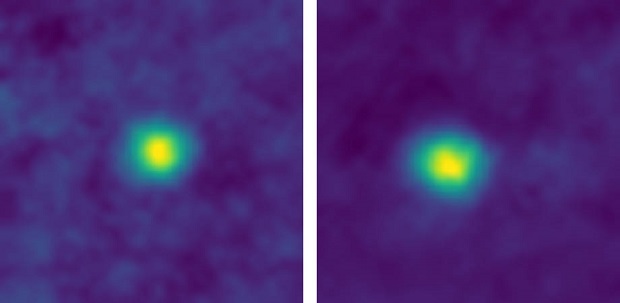LOOK: Farthest photos ever taken, from 6 billion kms away

With its Long Range Reconnaissance Imager (LORRI), New Horizons observed several Kuiper Belt objects (KBOs) and dwarf planets at unique phase angles, as well as Centaurs at extremely high phase angles to search for forward-scattering rings or dust. These December 2017 false-color images of KBOs 2012 HZ84 (left) and 2012 HE85 are, for now, the farthest from Earth ever captured by a spacecraft. They’re also the closest-ever images of Kuiper Belt objects. NASA/JHUAPL/SwRI
CAPE CANAVERAL, Florida, United States — The NASA spacecraft that gave us close-ups of Pluto has set a record for the farthest photos ever taken.
In December — while 3.79 billion miles (6.12 billion kilometers) from Earth — the New Horizons spacecraft snapped a picture of a star cluster. The photo surpassed the “Pale Blue Dot” images of Earth taken in 1990 by NASA’s Voyager 1.
The images for “Pale Blue Dot” — part of a composite — were taken 3.75 billion miles (6.06 billion kilometers) away.
New Horizons took more photos as it sped deeper into the cosmos in December. These pictures show two objects in the Kuiper Belt, the so-called twilight zone on the fringes of our solar system.
NASA released the images this week.
New Horizons flew past Pluto in 2015. It’s headed toward an even closer encounter with another icy world, 1 billion miles (1.6 billion kilometers) beyond Pluto, on Jan. 1, 2019. The targeted object is known as 2014 MU69; the spacecraft will pass within 2,175 miles (3,500 kilometers).
“New Horizons just couldn’t be better … we’re bearing down on our flyby target,” said lead scientist Alan Stern of the Southwest Research Institute in Boulder, Colorado.
New Horizons is currently in electronic hibernation. Flight controllers at a Johns Hopkins University lab in Laurel, Maryland, will awaken the spacecraft in June and start getting it ready for the flyby.
The spacecraft was launched in 2006. /cbb